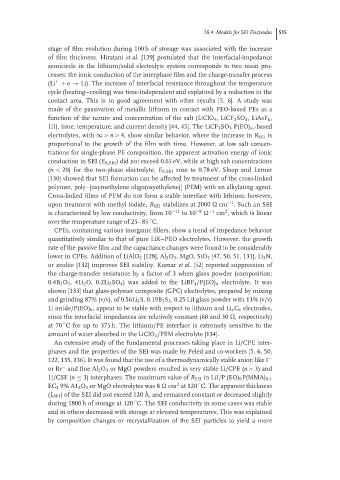Page 542 - Handbook of Battery Materials
P. 542
16.4 Models for SEI Electrodes 515
stage of film evolution during 100 h of storage was associated with the increase
of film thickness. Hiratani et al. [129] postulated that the interfacial-impedance
semicircle in the lithium/solid electrolyte system corresponds to two main pro-
cesses: the ionic conduction of the interphase film and the charge-transfer process
+
(Li + e → Li). The increase of interfacial resistance throughout the temperature
cycle (heating–cooling) was time-independent and explained by a reduction in the
contact area. This is in good agreement with other results [5, 6]. A study was
made of the passivation of metallic lithium in contact with PEO-based PEs as a
function of the nature and concentration of the salt (LiClO 4 , LiCF 3 SO 3 ,LiAsF 6 ,
LiI), time, temperature, and current density [44, 45]. The LiCF 3 SO 3 P(EO) n ,-based
electrolytes, with ∞ > n > 4, show similar behavior, where the increase in R SEI is
proportional to the growth of the film with time. However, at low salt concen-
trations for single-phase PE composition, the apparent activation energy of ionic
conduction in SEI (E A,SEI ) did not exceed 0.65 eV, while at high salt concentrations
(n < 20) for the two-phase electrolyte, E A,SEI rose to 0.78 eV. Sloop and Lerner
[130] showed that SEI formation can be affected by treatment of the cross-linked
polymer, poly–[oxymethylene oligo(oxyethylene)] (PEM) with an alkylating agent.
Cross-linked films of PEM do not form a stable interface with lithium; however,
−1
upon treatment with methyl iodide, R SEI stabilizes at 2000 cm .Such anSEI
2
is characterized by low conductivity, from 10 −12 to 10 −8 −1 cm , which is linear
over the temperature range of 25–85 C.
◦
CPEs, containing various inorganic fillers, show a trend of impedance behavior
quantitatively similar to that of pure LiX–PEO electrolytes. However, the growth
rate of the passive film and the capacitance changes were found to be considerably
lower in CPEs. Addition of LiAlO 2 [128], Al 2 O 3 , MgO, SiO 2 [47, 50, 51, 131], Li 3 N,
or zeolite [132] improves SEI stability. Kumar et al. [52] reported suppression of
the charge-transfer resistance by a factor of 3 when glass powder (composition:
0.4B 2 O 3 ,4Li 2 O, 0.2Li 2 SO 4 ) was added to the LiBF 4 /P(EO) n electrolyte. It was
shown [133] that glass-polymer composite (GPC) electrolytes, prepared by mixing
and grinding 87% (v/v), of 0.56Li 2 S, 0.19B 2 S 3 , 0.25 LiI glass powder with 13% (v/v)
Li imide/P(EO) 6 , appear to be stable with respect to lithium and Li x C 6 electrodes,
since the interfacial impedances are relatively constant (60 and 30 , respectively)
◦
at 70 C for up to 375 h. The lithium/PE interface is extremely sensitive to the
amount of water absorbed in the LiClO 4 /PEM electrolyte [134].
An extensive study of the fundamental processes taking place in Li/CPE inter-
phases and the properties of the SEI was made by Peled and co-workers [5, 6, 50,
122, 135, 136]. It was found that the use of a thermodynamically stable anion like I −
or Br and fine Al 2 O 3 or MgO powders resulted in very stable Li/CPE (n > 3) and
−
Li/CSE (n ≤ 3) interphases. The maximum value of R SEI in LiI/P (EO) 9 P(MMA) 0.5
2
◦
EC 1 9% A1 2 O 3 or MgO electrolytes was 8 cm at 120 C. The apparent thickness
(L SEI ) of the SEI did not exceed 120 ˚ A, and remained constant or decreased slightly
during 1800 h of storage at 120 C. The SEI conductivity in some cases was stable
◦
and in others decreased with storage at elevated temperatures. This was explained
by composition changes or recrystallization of the SEI particles to yield a more

